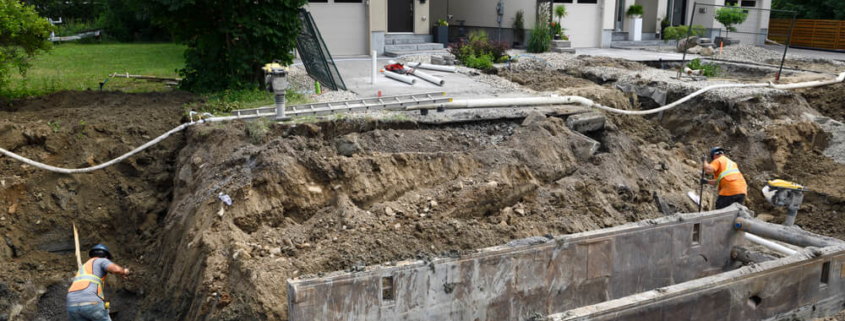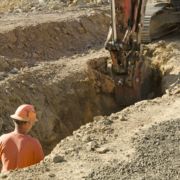OSHA Safety – Preventing Cave-Ins
Workers engaged in activities in and around excavations and trenches must be aware of the real possibility of a cave-in. In many situations, cave-ins are likely to occur if best practices aren’t followed, and workers fail to use the proper kind of protection to keep them safe. Failure to do this can have tragic consequences. Here is what you need to know about cave-in standards and protection.
Trench Cave-Ins Can Be Deadly
Trench collapses can result in serious injuries and even death. In 2020 alone, 21 workers died in workplace cave-ins. In just the last month of the year, employees in California, Georgia, Michigan, Virginia, and South Dakota lost their lives due to collapsed trenches. When accidents aren’t fatal, they can result in serious crushing injuries that require long-term medical care and may have lasting consequences.
What Causes a Cave-In?
Undisturbed soil will remain in place because of the dirt’s opposing vertical and horizontal forces. An excavation, such as a trench, removes some of the soil that formerly provided that important support.
What is left behind during an excavation is eventually going to slide down into the trench. Sometimes that movement is gradual, which just produces a mess that workers have to clean up. But there is a real danger that the downward movement could be sudden and unexpected, in the form of toppling, sluffing, or sliding. When there are other factors present, like vibration or water, these types of events become even more likely.
A trench cave-in can happen in an instant and kill workers just as fast. Cave-ins containing five cubic yards of soil will weigh up to 14,000 pounds. It would only take a victim a few minutes to suffocate under this much weight in addition to suffering serious internal injuries.
OSHA Safety Standards to Prevent Cave-Ins
Even though trench-related accidents, injuries, and deaths continue to happen, cave-ins are tragedies because they are 100% preventable if employers were to strictly follow OSHA prevention standards. Specifically, employers must comply with OSHA’s excavation and trenching requirements laid out in 29 CFR 1926.651 and 1926.652 or equivalent OSHA-approved state plan requirements.
Trench Safety Measures
There must be a protective system in place if a trench is five feet deep or more unless the entire excavation is made of stable rock. If the trench is less than five feet deep, a competent person must determine whether or not a protective system is needed.
Trenches that are 20 feet deep or more must have a protective system in place that has been designed by a qualified engineer. Or, the system can be based on data prepared by or approved by an engineer.
Competent Person in Trench Safety
Because trenches are so hazardous, OSHA requires that safety systems and tasks that happen inside the trenches be designed by or assigned to a “competent person.” OSHA defines this as someone who has been trained to identify existing and predictable excavation hazards and who also has the authority to take fast action to eliminate any hazards.
Trench Access and Egress
OSHA has some specific guidelines about how workers should enter and exit trenches for the sake of worker safety and to prevent serious cave-ins. If dangerous conditions arise inside the trench, it’s important that workers are able to make a quick exit. For example, a trench that is four feet or more deep must have a ladder, ramp, or stairway that is within 25 feet of workers.
All structural ramps must be designed by a competent person. If a ramp is used instead of steps, it must have a non-slip surface.
Trench Protective Systems
The basic method to protect workers from cave-ins is to use shoring, benching, sloping, and shielding. Which method you use will depend on a variety of factors, such as the type of soil, its water content, and the depth and width of the trench.
Shoring refers to the installation of supports to prevent soil movement and cave-ins. Benching is the method of creating a series of steps with the soil. Sloping involves angling the wall of the trench away from the bottom of the excavation. And shielding employs boxes or other supports to protect workers from sliding debris.
Other Trench Safety Best Practices
According to OSHA, employers must also follow several other best practices to prevent cave-ins and keep workers safe:
- Keep heavy equipment away from trench edges.
- Identify underground utilities before digging.
- Test for hazards such as toxic gasses and low oxygen in trenches.
- Inspect trenches before and after each shift and following any rainfall.
- Ensure workers wear high-visibility clothing in trenches.
Learn More About Preventing Cave-Ins in the Workplace
If you’ve suffered an injury from a trench cave-in or have lost a loved one to such a tragedy, it’s important to understand that employers have a duty to provide a safe work environment that protects workers from these types of accidents. Having appropriate guidelines, training, and protection in place is a vital part of workplace safety and cave-in prevention. To learn more about protecting yourself from cave-ins in the workplace, contact OSHA Injury Attorney directly.




 OSHA Safety Guidelines for Dock Workers
OSHA Safety Guidelines for Dock Workers
Leave a Reply
Want to join the discussion?Feel free to contribute!